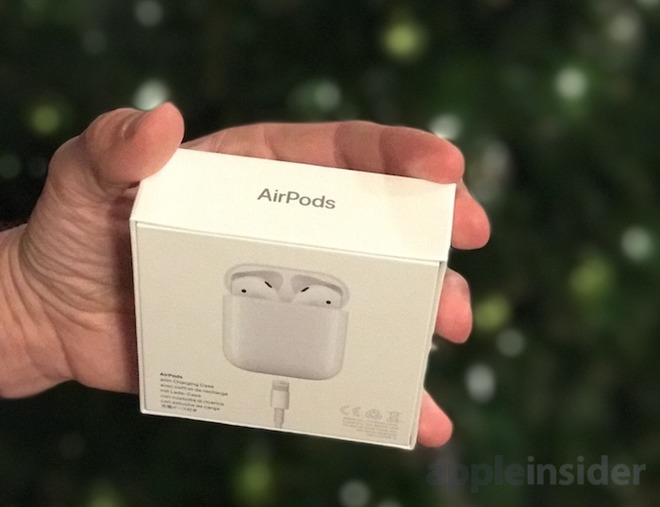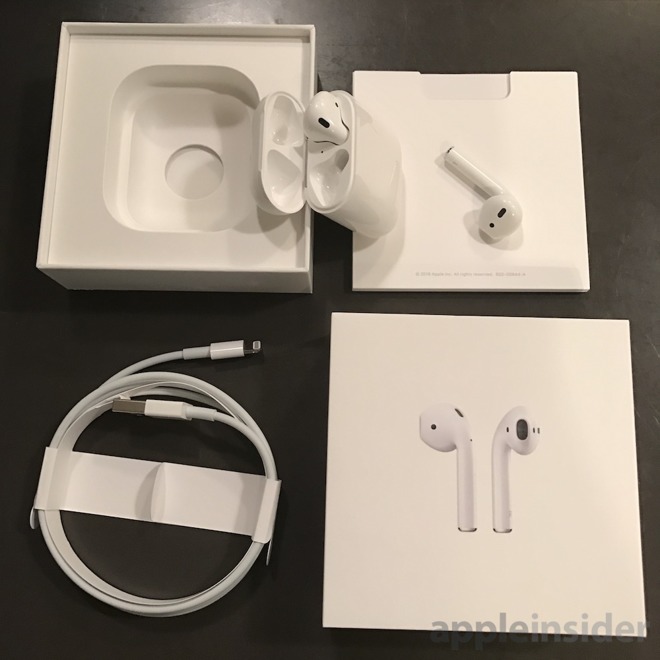Apple's new AirPods wireless headphones are just hitting the market--albeit nearly two months later than intended--delivering sleek, minimalist style and powerful underlying tech that's super easy to use in an apparent homage to the company's original music offering: iPod.

What's Apple's most power efficient new computer of 2016 featuring a brilliantly simple new user interface? Beyond the 9.7-inch iPad Pro and the iPhone 7 and 7 Plus, Apple Watch Series 2 and the slim new MacBook Pro with Touch Bar, there's a new wearable featuring advanced audio beam-forming and wireless delivery: AirPods!

AirPods work with your Mac (macOS 10.12), iPhone, iPad or iPod touch (running iOS 10) and AppleWatch (with watchOS 3). They're standard Bluetooth 4 enhanced with Apple's "special sauce" effortless proximity pairing software that uses your iCloud account to seamlessly link to your notebook, then your iPhone, and even to Apple Watch while you run. They will also work with standard Bluetooth audio sources.
With iOS 10, just open the AirPod case and a panel slides open on your iPhone with a single Connect button
Apple's AirPods are light and small--a major differentiation from Samsung's own wearable, wireless headphones earlier this year, which bundled in a music player and song storage--an engineering choice that significantly inflated the price, size and weight of the product. Apple's target customers likely already carry a music player and storage, perhaps even on their wrist.
AirPods are only slightly larger than Apple's wired EarPods
Another interesting departure from the status quo made by Apple with AirPods is its personal approach to voice assistance. Using a voice accelerometer and beam-forming microphones for noise supression, the new earpieces offer a mobile, personal take on Siri that's a major divergence from the always-listening Echo living room appliance sold by Amazon (and subsequently aped by Google and now Microsoft).
Apple still needs to prove that Siri can keep up with Amazon's Alexa and Google's leadership in search--but by installing personal earbuds on its hundreds of millions of users globally, it can improve upon Siri in ways and on a scale that Amazon's single digit millions of Echos, largely limited to the United States, can't.
It might seem curious that Apple is selling AirPods itself rather than through its Beats subsidiary that also sells the around-the-ear Powerbeats3 (below) and the upcoming BeatsX in-ear headphones, both of which use the same W1 chip Apple developed for AirPods. However, AirPods continue Apple's trajectory as a music hardware innovator, beginning with iPod.
Apple's audio-powered ascent from conventional computers
In 2001, film predicted we'd make contact with aliens. Instead, Steve Jobs introduced iPod, a novel departure from Apple's conventional computer business, and a first big step into the world of music. Apple's focus on music has gotten louder with its 2014 acquisition of Beats, which aligned the Silicon Valley tech company with the business end of the Los Angeles music scene
iPod--along with iTunes software--revolutionized the way music was listened to, and--soon afterward--how it would be sold. Apple's focus on music has gotten louder with its 2014 acquisition of Beats, which aligned the Silicon Valley tech company with the business end of the Los Angeles music scene.
Over the past decade and a half, Apple's iPod shifted millions of casual music listeners from CDs to an ultra portable digital drive, while also shifting the center of the premium market for audiophile equipment toward mobile devices, rather than fixed component stereo equipment installed in a den.
It has also all but erased individuals' huge physical libraries of sound recorded on plastic media with iTunes digital downloads via iCloud, and most recently, with Apple Music on-demand streaming, now boasting 20 million subscribers.
The advantages of mobility in music playback with iPod had a strong parallel to the same shift happening in computers, where desktop PCs were increasingly replaced with notebooks and even handheld PDA devices and eventually smartphones.
Apple linked its mobile iPods with iconically branded white headphones. While every mobile MP3 player essentially looked the same, iPods' white earbuds let everyone around you know that you were listening to music with an iPod, and therefore served as a core tenant of Apple's marketing, both in ads and by word of mouth.
Wireless headphones a difficult task
Those headphones were also one of the worst aspects of the iPod: while they delivered generally adequate sound, their easily tangled wires were a hassle. By 2004, it seemed obvious that the solution should be... wireless headphones! However, actually solving that ostensibly simple issue took a lot longer.
Along the way, Apple solved a series of easier problems: it shrank the iPod down into an incredibly thin device, then used its macOS platform software to develop a mobile computer that could not only act as an iPod, but also as a "breakthrough Internet device" and a mobile phone: 2007's iPhone.
In audio, rather than tackling wireless headphones, Apple first introduced its external iPod HiFi, a speaker system that proved to be a lackluster dud in competition with smaller, lighter and cheaper alternatives. It also developed AirTunes--later rebranded AirPlay--as a wireless method of streaming audio to external speakers from a Mac or iOS device, via its now-discontinued AirPort WiFi basestations.
Apple Beats in Bluetooth
Apple's iOS devices, and eventually some iPods, also used industry standard Bluetooth for audio integration in cars and with third party wireless speakers.
In 2011, iPhone 4S was the first smartphone to roll out Bluetooth 4, incorporating a new "LE" standard in high efficiency "Smart" wireless that Apple aggressively adopted across its product line while Microsoft, Google and Samsung lagged behind, distracted in part by NFC.
The Bluetooth specification also enabled support for early generations of bulky, quirky wireless headsets, but these were slow to take off in popularity.
Apple planned to change that after having acquired Beats. In the U.S., Beats already accounts for a leading 32 percent revenue share of all headphones--46 percent among Bluetooth headsets and 60 percent of the premium headphone category--according to NPD.
iPod turns 15 as AirPods arrive
Not until 2016--a full decade and a half after iPod debuted--did Apple show off its own take on wireless headphones with AirPods. Why did it take so long?
For starters, Apple knew it couldn't simply float out a basic product offering (the way Jobs had with HiFi speakers in 2006). It had to offer a remarkable advance over the status quo. AirPods build upon Bluetooth with special hardware and software that makes secure pairing between multiple devices effortless.
That's a compelling feature for users who today want to move from their Mac to their iOS device to their Apple Watch. Unpairing and repairing between devices is a particular hassle with basic Bluetooth.
Macs can connect to AirPods via Bluetooth, Audio settings or within iTunes
You can move from your Mac to iPhone just by flicking up Control Center and selecting output to your AirPods
Another major issue for compact wireless headphones is battery life. Apple owns leading battery technology developed for its notebooks and mobile devices, as well as highly efficient software that seeks to conserve power as aggressively as possible.
Additionally, since 2008 the company has been diligently working to develop ARM-based silicon to do powerful work using the least energy possible. Apple's silicon savvy is most prominent in each generation of iPhone with its A-series Application Processor, but is also at work in Apple Watch, powered by a energy efficient logic package known as the S1 and S2.
A close relative of Apple Watch ARM chip is used in Apple's latest MacBook Pro to control and secure its Touch ID and Touch Bar input subsystem.
For AirPods, Apple developed W1, custom silicon to handle both efficient processing and wireless transmission. The new chip also borrows from existing iPhone work to isolate and recognize speech using beam-forming. This supports the use of Siri on AirPods as a handsfree interface for audio playback, as well as accessing information through an iPhone's mobile Internet connection.
Apple's second wearable
More than just being Bluetooth headphones, AirPods are Apple's second major wearable. Just as Apple Watch makes the most of its location on your wrist--the ideal location for putting a glanceable watch display for notifications as well a serviceable spot for tracking your pulse--AirPods use their perch in your ear canal to not just play back audio but also direct microphone pickup toward your mouth. AirPods use their perch in your ear canal to not just play back audio but also direct microphone pickup toward your mouth
AirPods can sense when they're installed to automatically begin playback, and can function both in stereo or individually in mono. That extends their use, as you can listen on one while the other recharges.
Paired with Apple Watch, you can now use AirPods to listen to music, podcasts or other audio--as a set of wearable devices that are small enough and styled so as to pass as jewelry.
Rather than being radically intrusive the way Google imagined for its ill fated Glass headgear computer concept, AirPods look like standard EarPod headphones with the wires clipped off, and its wired control buttons evolved into a set of highly directional mics that can be activated with the bump of a touch.
Design for experience
The first decade of basic, angular white earbuds sold with iPods and iPhones felt like basic placeholders. Apple acknowledged as much by selling a premium, optional set of "In-Ear Headphones" between 2008 and 2012, advertised as being "engineered for superior acoustic accuracy, balance, and clarity."
However, in 2012 Apple introduced an enhanced earbud design bundled with iPhone 5 it branded as EarPods, offering better sound right in the box. Rather than continuing to develop its own premium headphones, Apple carried third party headphones in its retail stores, and ultimately acquired Beats two years later.
It wasn't clear until Apple's iPhone 7 event whether the company would continue to resell wireless Beats, or offer its own Apple-branded, premium headphones. It turns out the company did both.
Because the primary leaks in Apple's operational strategy come from its supply chain, it was first discovered that the upcoming iPhone 7 would be dropping its analog audio jack.
However, not until the actual announcement was it known that Apple planned to bundle the new phone with Lightning-equipped EarPods (below), as well as offer fully wireless new AirPods along with Beats-branded alternative wireless headphones featuring the same W1 technology.
AirPods appear to earn Apple's white branding due to their minimal, iPod-esque design: EarPods without the wires, which snugly fit into a carrying case that doubles as a battery pack for recharging. Placing the individual AirPod units in the case recharges each via two electrical contacts (below), rather than using "wireless" induction like Apple Watch.
The AirPods' recharging case feels superior to Apple Watch and its induction charging disc cable, however--the AirPods' case plugs into a standard USB-Lightning cable. You can charge it the same way you charge your iPhone (and Apple TV Siri remote and third party controllers); no need to diddle with a separate, specialized cable.
It would be ideal if Apple Watch came with a similar Lightning-enabled charging device. As it stands, the Apple Watch Magnetic Charging Dock is the only accessory to feature Lightning input, and it costs an extra $80. Perhaps Apple could add an Apple Watch induction charging spot to the AirPods case to kill two battery birds with one stone, as many buyers attracted to Apple Watch are likely to also be interested in Apple's other wearable.
Given that Apple Watch was the company's first leap into wearable fashion--delivering technology tightly wrapped in a stylish design intended to be discreet yet also displayed--AirPods' very visible nature when worn (and its smart, compact carrying case) show a trend of Apple progressing along the same trajectory of smart, clean design that began with iPod: technology at the corner of the liberal arts.
I think Jobs would approve.
